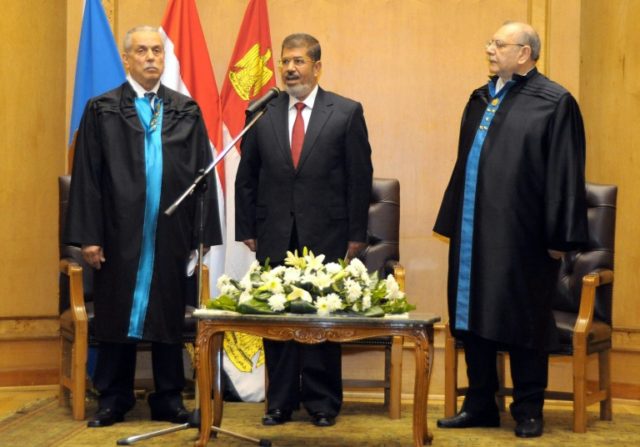Cairo (AFP) – The Muslim Brotherhood, from which hailed Egypt’s former president Mohamed Morsi who died on Monday, is the oldest and biggest representative of political Sunni Islam in Egypt.
Here is a brief history of the movement:
– Foundation –
In March 1928 the Muslim Brotherhood is founded in the Suez Canal city of Ismailiya by imam Hassan al-Banna, who takes the title of guide of the movement.
Its beginnings are as a welfare group, before taking on a political role, based on opposition to the British presence and in support of an Islamic state.
– Banna killed –
In December 1948, a Muslim Brother assassinates prime minister Mahmud Fahmi al-Nuqrashi, who had ordered the Brotherhood dissolved. From then on the group is brutally repressed.
In February 1949 Banna is murdered by the secret police.
– Sayyed Qotb executed –
In 1954, President Gamal Abdel Nasser decides to ban the Brotherhood after it is blamed for an assassination attempt against him.
In August 1966, Sayyed Qotb, a theoretician behind the movement who inspired its radicalisation, is hanged by Nasser’s regime.
Until Nasser’s death in 1970, the Muslim Brotherhood are arrested in their thousands or go underground.
– Sadat assassinated –
In 1971, Anwar Sadat who succeeds Nasser as president and seeks to neutralise the Nasserian left, grants the Brotherhood’s leadership amnesties.
On October 6, 1981 Sadat, vilified by many in the wider Arab world for signing a peace treaty with Israel without obtaining concessions for the Palestinians, is assassinated by Islamic extremist soldiers.
– Religious organisation –
In 1984 the regime of Sadat’s successor, Hosni Mubarak, recognises the movement as a religious organisation but refuses its registration as a political party. The Brotherhood fields candidates on independent tickets.
In 2005 after a breakthrough in legislative elections in which its sympathisers gain one-fifth of parliamentary seats, it emerges empty-handed from the first round of the 2010 elections and boycotts the second round, denouncing massive fraud.
– Out of hiding –
On February 11, 2011 Mubarak steps down and hands his powers to the military on the 18th day of a popular uprising. The movement sides with the revolt progressively.
The Brotherhood founds its political wing, the Freedom and Justice Party.
The Muslim Brotherhood and Islamist allies clinch an overwhelming majority in staggered legislative polls in 2011-2012.
– Morsi elected then ousted –
On June 30, 2012, Morsi, the Muslim Brotherhood’s candidate who won 51.73 percent of the vote in a presidential election, is sworn in as Egypt’s first head of state chosen in a free vote, and also the first Islamist and civilian to head the country.
On July 3, 2013, after massive popular demonstrations, the army ousts Morsi, who is arrested along with his guards.
– Repression –
On August 14, 2013, security forces storm two huge Cairo protest camps occupied for weeks by supporters of Morsi, leaving 700 people dead in 12 hours, according to official sources.
In total more than 1,400 pro-Morsi protesters are killed over several months.
Most Muslim Brotherhood leaders and thousands of Islamist opponents are arrested. Hundreds, including Morsi, are sentenced to death.
– ‘Terrorist organisation’ –
In late 2013, the Muslim Brotherhood is declared a “terrorist organisation” by the judiciary, before their political arm is dissolved in 2014.
In April 2019, the White House says that President Donald Trump plans to put the Brotherhood on the US terrorist blacklist.
The announcement comes three weeks after the visit to the White House of current Egyptian leader Abdel Fattah al-Sisi.
– ‘Slow death’-
On June 17, 2019, Morsi dies after falling ill during a court hearing, the attorney general says.
The Muslim Brotherhood accuses the Egyptian authorities of being responsible for Morsi’s “deliberate slow death”.

COMMENTS
Please let us know if you're having issues with commenting.